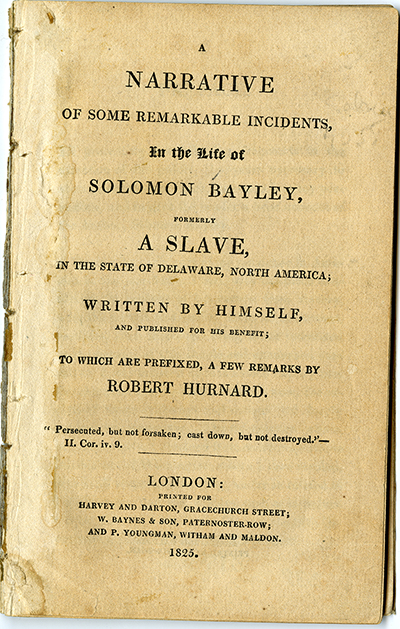

Delaware history with the Underground Railroad
October 03, 2017
Learn about the First State's importance to the system
Explore Delaware’s role in the Underground Railroad and the abolition movement in the University of Delaware Library, Museums and Press’ one-case exhibition, “Delaware and the Underground Railroad.”
Curated by Alex Johnston, associate librarian in Special Collections, the exhibition will on view in the first floor exhibition area of Morris Library through Nov. 3.
Among the items on display is Solomon Bayley’s 1825 memoir, A Narrative of Some Remarkable Incidents in the Life of Solomon Bayley: Formerly a Slave in the State of Delaware, North America, which is the only known example of a memoir that was written and published by an enslaved Delawarean.

Nineteenth-century publications about the Underground Railroad and the abolitionist movement will also be on display, including one of the first biographies of Harriet Tubman, whose route between Pennsylvania and Maryland took her back and forth through Delaware.
As a border state, Delaware sat directly along the Underground Railroad lines used by escaped slaves to reach the northern states and Canada.
Although allied with the Union during the Civil War, Delaware remained a slave state until 1865, when the ratification of the 13th amendment to the Constitution banned slavery nationwide.
In general, the state was divided along north/south lines, where northern New Castle County was primarily anti-slavery and southern Sussex County opposed abolition.
Prior to the Civil War, the Underground Railroad operated as a series of safe houses from which sympathetic Northerners and members of the free African-American community provided refuge, shelter and support for escaped slaves.
The system was so-named due to the fact that railroad terminology was used to describe its functions. Routes were referred to as “lines,” stopping places were “stations” and people aiding the escaped slaves were “conductors.” Conductors aided escaped slaves in defiance of the Fugitive Slave Act that permitted authorities to cross state lines in pursuit of escaped slaves and provided civil and criminal penalties to anyone who aided them.
Common Reader-related programming
The Common Reader is a University-wide program in which University of Delaware first-year students read a selected work prior to the beginning of the fall semester. This year's Common Reader is Colson Whitehead's Pulitzer Prize-winning novel, The Underground Railroad.
On Oct. 9, join the Library for a Brown Bag Lunch Discussion on the book. Participants will dive deeper into the story by sharing perspectives and gaining insight from fellow readers and attendees. The book discussion, which is open to the entire campus community, will be led by Lauren Wallis, First Year Experience and Student Success Librarian. It will be held from noon to 1 p.m. in the 1941 Lecture Room in Morris Library.
In addition, the “Delaware and the Underground Railroad” exhibition is presented as part of “Representations of Slavery and Freedom: First Year Experience Historical Tour,” a self-guided tour which allows first-year students to explore primary sources and historical artifacts related to the legacy of slavery in the United States. The programming was developed to support the First Year Experience program and the Common Reader.
Special Collections and Museums
Special Collections and Museums is part of the University of Delaware Library, Museums and Press. An interdisciplinary collection of rare and unique materials can be accessed for study and research, and is also featured in exhibitions in the Special Collections Gallery in Morris Library, Old College Gallery, Mechanical Hall Gallery and the Mineralogical Museum in Penny Hall. All Special Collections and Museums events and exhibitions are free and open to the public.
The collection has particular strengths in the subjects of history and Delawareana; science and technology; art and literature; primary source material such as political papers and ships’ logs; American art of the 20th century, especially prints, photographs and work by African American artists; European prints; Inuit art; Pre-Columbian art; and minerals. In addition, the Mark Samuels Lasner Collection, gifted to UD in 2016, strengthens the collection’s focus on British literature of the 19th and early 20th centuries.
Contact Us
Have a UDaily story idea?
Contact us at ocm@udel.edu
Members of the press
Contact us at 302-831-NEWS or visit the Media Relations website

